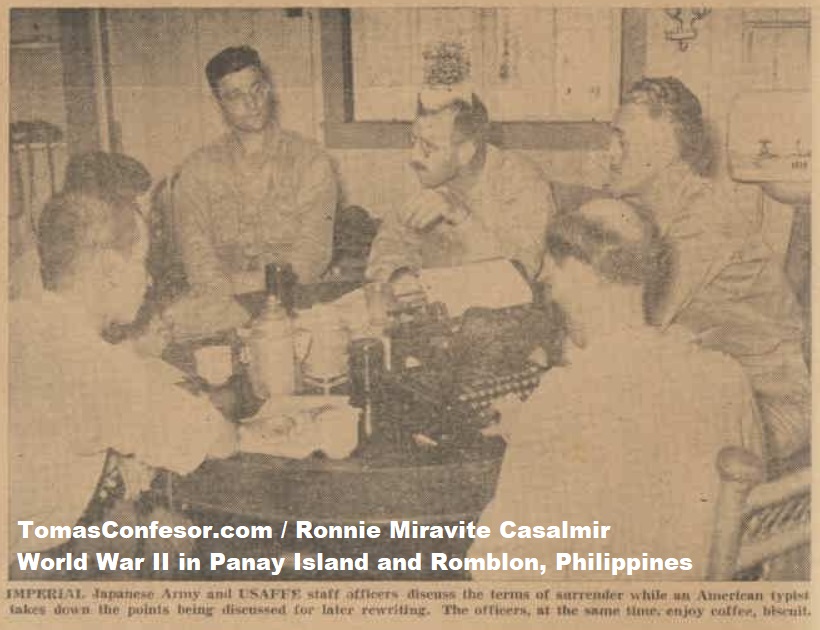
IMPERIAL Japanese Army and USAFFE staff officers discuss the terms of surrender while an American typist takes down the points being discussed for later rewriting. The officers, at the same time, enjoy coffee, biscuit.

Surrender at Calinog, Iloilo, of the commanding general of the USAFFE's 61st Division, Colonel Albert Christie (2nd from right), Maj. Fukui is 2nd from left, and to his right (3rd from left) is Col. Yasumi Seno, commander of the Seno Unit).
The Blood and Mud in the Philippines

A COMMISSIONER of the Fil-Amerlcan forces in Iloilo signs the paper of unconditional surrender. Looking on at his side of the table are two members of the USAFFE staff. At the other side are Japanese staff officers.
|
May 19, 1945 - Lt. Col. Allan Thayer, staff officer of the USFIP, arrived at Cabatuan Airfield (in Cabatuan, Iloilo) in order to coordinate the surrender of the USAFFE in Panay. May 24, 1945 - Division Commander Christie and 1,800 men surrendered to the Japanese force. May 29, 1945 - A U.S. major surrendered to the Takahashi Company of the Japanese Army at Daja, Maasin. - The Blood and Mud in the Philippines |
|
During the time that the Kawamura Detachment was operating in Panay, the Japanese forces in Luzon had launched a general attack on Corregidor. At Corregidor on May 6, 1942, US Lieutenant General Jonathan Wainwright surrendered all US and Philippine forces that had been resisting the Japanese throughout the Philippine Islands.
Lieutenant Colonel Alan Thayer was a staff officer of the USFIP (US Forces in the Philippines) assigned to the Visayas and Mindanao.13 In the early morning of May 19, he flew to the town of Cabatuan, Iloilo, with Japanese escorts. He relayed the order of surrender issued by Major General Willlam F. Sharp, Commander for Visayas and Mindanao to Colonel Alben Christie of the 61st Division situated at Mt. Baloy. On May 24, 1942, Colonel Christie and other high-ranking officers surrendered to the Japanese Army with about 1,800 soldiers. The remaining 6,000 officers and men either remained in seclusion in the mountains with their weapons or went home to their families. This resulted to the apparent break-up of the military organization in Panay. - The Blood and Mud in the Philippines, Section 1.2 |

